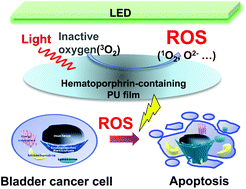当前位置:
X-MOL 学术
›
Photochem. Photobiol. Sci.
›
论文详情
Our official English website, www.x-mol.net, welcomes your feedback! (Note: you will need to create a separate account there.)
Suppression of T24 human bladder cancer cells by ROS from locally delivered hematoporphyrin-containing polyurethane films
Photochemical & Photobiological Sciences ( IF 3.1 ) Pub Date : 2018-04-18 00:00:00 , DOI: 10.1039/c7pp00424a Dohyun Kim 1, 2, 3, 4, 5 , Mi Hee Lee 1, 2, 3, 4, 5 , Min-Ah Koo 1, 2, 3, 4, 5 , Byeong-Ju Kwon 1, 2, 3, 4, 5 , Min Sung Kim 1, 2, 3, 4, 5 , Gyeung Mi Seon 1, 2, 3, 4, 5 , Seung Hee Hong 1, 2, 3, 4, 5 , Jong-Chul Park 1, 2, 3, 4, 5
Photochemical & Photobiological Sciences ( IF 3.1 ) Pub Date : 2018-04-18 00:00:00 , DOI: 10.1039/c7pp00424a Dohyun Kim 1, 2, 3, 4, 5 , Mi Hee Lee 1, 2, 3, 4, 5 , Min-Ah Koo 1, 2, 3, 4, 5 , Byeong-Ju Kwon 1, 2, 3, 4, 5 , Min Sung Kim 1, 2, 3, 4, 5 , Gyeung Mi Seon 1, 2, 3, 4, 5 , Seung Hee Hong 1, 2, 3, 4, 5 , Jong-Chul Park 1, 2, 3, 4, 5
Affiliation

|
Systemic injection of a photosensitizer is a general method in photodynamic therapy, but it has complications due to the unintended systemic distribution and remnants of photosensitizers. This study focused on the possibility of suppressing luminal proliferative cells by excessive reactive oxygen species from locally delivered photosensitizer with biocompatible polyurethane, instead of the systemic injection method. We used human bladder cancer cells, hematoporphyrin as the photosensitizer, and polyurethane film as the photosensitizer-delivering container. The light source was a self-made LED (510 nm, 5 mW cm−2) system. The cancer cells were cultured on different doses of hematoporphyrin-containing polyurethane film and irradiated with LED for 15 minutes and 30 minutes each. After irradiating with LED and incubating for 24 hours, cell viability analysis, cell cycle analysis, apoptosis assay, intracellular and extracellular ROS generation study and western blot were performed. The cancer cell suppression effects of different concentrations of the locally delivered hematoporphyrin with PDT were compared. Apoptosis dominant cancer cell suppressions were shown to be hematoporphyrin dose-dependent. However, after irradiation, intracellular ROS amounts were similar in all the groups having different doses of hematoporphyrin, but these values were definitely higher than those in the control group. Excessive extracellular ROS from the intended, locally delivered photosensitizer for photodynamic treatment application had an inhibitory effect on luminal proliferative cancer cells. This method can be another possibility for PDT application on contactable or attachable lesions.
中文翻译:

ROS从局部递送的含血卟啉的聚氨酯膜中抑制T24人膀胱癌细胞
全身注射光敏剂是光动力疗法中的常规方法,但是由于不希望的全身分布和光敏剂的残留,它具有并发症。这项研究的重点是通过生物相容性聚氨酯代替局部注射方法,通过局部递送的光敏剂中过量的活性氧来抑制腔内增殖细胞。我们使用人类膀胱癌细胞,血卟啉作为光敏剂,并使用聚氨酯薄膜作为光敏剂输送容器。光源是自制的LED(510 nm,5 mW cm -2) 系统。在不同剂量的含血卟啉的聚氨酯膜上培养癌细胞,并分别用LED照射15分钟和30分钟。用LED照射并孵育24小时后,进行细胞活力分析,细胞周期分析,细胞凋亡测定,细胞内和细胞外ROS生成研究以及蛋白质印迹。比较了不同浓度的局部递送血卟啉与PDT对癌细胞的抑制作用。凋亡占优势的癌细胞抑制作用被证明是血卟啉剂量依赖性的。但是,照射后,血卟啉剂量不同的所有组的细胞内ROS量均相似,但这些值肯定高于对照组。预期的细胞外ROS过多,用于光动力治疗应用的局部递送的光敏剂对管腔增殖癌细胞具有抑制作用。对于PDT应用于可接触或可附着的病变,该方法可能是另一种可能性。
更新日期:2018-04-18
中文翻译:

ROS从局部递送的含血卟啉的聚氨酯膜中抑制T24人膀胱癌细胞
全身注射光敏剂是光动力疗法中的常规方法,但是由于不希望的全身分布和光敏剂的残留,它具有并发症。这项研究的重点是通过生物相容性聚氨酯代替局部注射方法,通过局部递送的光敏剂中过量的活性氧来抑制腔内增殖细胞。我们使用人类膀胱癌细胞,血卟啉作为光敏剂,并使用聚氨酯薄膜作为光敏剂输送容器。光源是自制的LED(510 nm,5 mW cm -2) 系统。在不同剂量的含血卟啉的聚氨酯膜上培养癌细胞,并分别用LED照射15分钟和30分钟。用LED照射并孵育24小时后,进行细胞活力分析,细胞周期分析,细胞凋亡测定,细胞内和细胞外ROS生成研究以及蛋白质印迹。比较了不同浓度的局部递送血卟啉与PDT对癌细胞的抑制作用。凋亡占优势的癌细胞抑制作用被证明是血卟啉剂量依赖性的。但是,照射后,血卟啉剂量不同的所有组的细胞内ROS量均相似,但这些值肯定高于对照组。预期的细胞外ROS过多,用于光动力治疗应用的局部递送的光敏剂对管腔增殖癌细胞具有抑制作用。对于PDT应用于可接触或可附着的病变,该方法可能是另一种可能性。



























 京公网安备 11010802027423号
京公网安备 11010802027423号